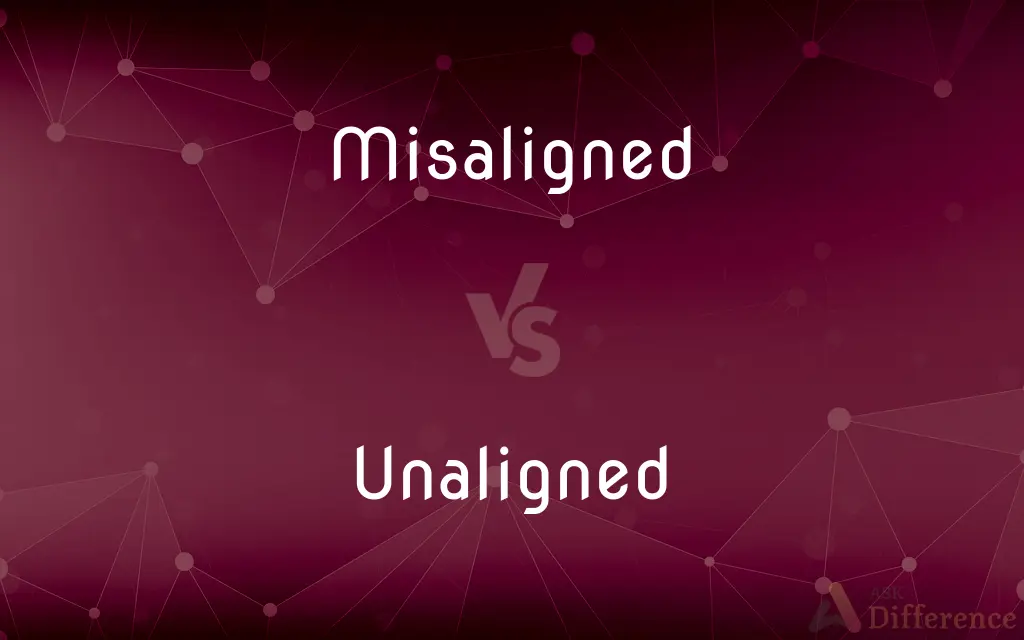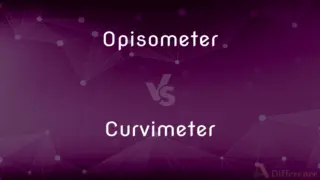Misaligned vs. Unaligned — What's the Difference?
By Maham Liaqat & Fiza Rafique — Updated on March 22, 2024
Misaligned refers to things incorrectly positioned relative to each other, while unaligned indicates no alignment or partnership, especially in contexts like politics or relationships.

Difference Between Misaligned and Unaligned
Table of Contents
ADVERTISEMENT
Key Differences
Misaligned typically describes objects, components, or ideas that have been positioned incorrectly or out of proper alignment with each other. On the other hand, unaligned generally refers to entities, groups, or individuals that have not been aligned, associated, or affiliated with any particular side, group, or standard. In political or ideological contexts, it suggests neutrality or independence from major blocs or viewpoints.
Misalignment can cause problems or inefficiencies, as it indicates that an attempt at correct placement or agreement has gone awry. This can lead to physical issues, like machinery failing to operate smoothly, or conceptual challenges, such as goals or strategies that do not properly coincide. Unaligned, however, suggests a deliberate choice or a state of being outside established groups or norms, without implying error. This could be beneficial in situations where neutrality or independence from prevailing standards or alliances is desired.
In practical applications, addressing misalignment involves correction and realignment to achieve the intended fit or agreement. This might entail physical adjustments, such as realigning car tires, or conceptual ones, like aligning project goals with actual outcomes. Conversely, being unaligned may require maintaining a stance of neutrality or independence, ensuring that actions or policies do not inadvertently align with those of other groups or standards.
The distinction between misaligned and unaligned is crucial in diagnosing issues and determining approaches. Misalignment suggests a problem that needs fixing to meet a specific standard or expectation. In contrast, unaligned situations may reflect a strategic position or a current state that does not align with any particular direction, requiring a different kind of management or approach.
While misalignment often carries a negative connotation due to the implied error or discrepancy, unaligned can be neutral or positive, depending on the context. Being unaligned can offer flexibility, freedom from constraints, and the ability to navigate between various options or opinions without being tied to one.
ADVERTISEMENT
Comparison Chart
Definition
Incorrectly positioned or not in proper alignment
Not aligned or affiliated with any side, group, or standard
Implication
Error or discrepancy in positioning or agreement
Neutrality or independence from established groups or norms
Typical Usage
Mechanical parts, strategies, goals
Political affiliations, ideological stances
Correction
Involves realignment to correct positioning or agreement
May involve maintaining neutrality or independence
Connotation
Generally negative, implying a problem
Neutral or positive, depending on context
Compare with Definitions
Misaligned
Misalignment often necessitates adjustments for proper function.
Misaligned objectives led to a realignment of the project goals.
Unaligned
Unaligned can be a deliberate choice or position.
Choosing to remain unaligned, the mediator facilitated the discussion.
Misaligned
Misaligned refers to things improperly aligned, causing dysfunction.
The misaligned gears caused the clock to stop.
Unaligned
Unaligned denotes a lack of affiliation or alignment with any group.
The unaligned countries formed a neutral bloc during negotiations.
Misaligned
Can apply to physical objects and conceptual ideas.
Their priorities were misaligned, leading to conflicts in the team.
Unaligned
Suggests freedom from external constraints or biases.
The unaligned research institute conducted impartial studies.
Misaligned
It suggests a deviation from the correct or intended alignment.
The misaligned tiles made the floor look uneven.
Unaligned
It emphasizes independence or neutrality.
Their stance remained unaligned with any political party.
Misaligned
Indicates an error that has practical implications.
The printer was jamming due to misaligned paper.
Unaligned
Applies more to political, ideological, or relational contexts.
As an unaligned voter, she considered all candidates equally.
Misaligned
Incorrectly aligned.
Unaligned
Nonaligned
Unaligned nations.
Misaligned
Out of alignment.
Unaligned
Not aligned
Misaligned
Simple past tense and past participle of misalign
Misaligned
Aligned improperly; not correctly aligned.
Common Curiosities
Is misalignment always negative?
Misalignment typically has negative implications because it suggests a deviation from what is correct or optimal, requiring correction.
Can a person be unaligned but not neutral?
Yes, someone can be unaligned with specific parties or ideologies but still hold strong personal convictions that are not neutral.
How can unaligned status benefit an organization or country?
Being unaligned allows for greater autonomy, the ability to make decisions based on one's interests rather than group pressures, and the potential to act as a mediator or neutral party.
What steps can be taken to correct misalignment?
Correcting misalignment typically involves adjusting the position or alignment of the misaligned elements to achieve the desired fit or agreement.
What does it mean when something is misaligned?
Something is misaligned when it is not correctly positioned or aligned with another object or a standard, often leading to dysfunction or inefficiency.
How does unaligned differ from neutral?
Unaligned specifically refers to not being aligned with any group or standard, while neutral can imply a state of impartiality or non-involvement. Unaligned is a form of neutrality with an emphasis on lack of alignment.
Can a strategy be both misaligned and unaligned?
A strategy could be misaligned with intended goals while also being unaligned with prevailing standards or practices, indicating both an error and a lack of adherence.
Why might an entity choose to remain unaligned?
An entity might choose to remain unaligned to preserve independence, flexibility, or neutrality, avoiding the constraints or conflicts associated with alignment.
How is unaligned viewed in international relations?
In international relations, being unaligned often means not being part of major alliances or blocs, which can be strategic for maintaining sovereignty and flexibility in foreign policy.
What are examples of misalignment in everyday life?
Examples include misaligned wheels on a vehicle affecting driving performance or misaligned goals in a project leading to inefficiencies.
Share Your Discovery

Previous Comparison
Opisometer vs. Curvimeter
Next Comparison
Pell vs. MellAuthor Spotlight
Written by
Maham LiaqatCo-written by
Fiza RafiqueFiza Rafique is a skilled content writer at AskDifference.com, where she meticulously refines and enhances written pieces. Drawing from her vast editorial expertise, Fiza ensures clarity, accuracy, and precision in every article. Passionate about language, she continually seeks to elevate the quality of content for readers worldwide.














































